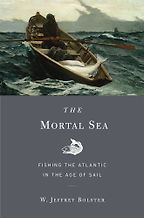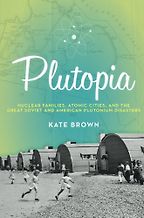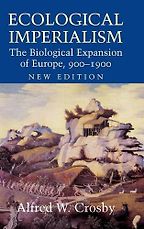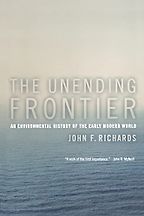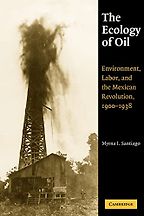You have been recognised as one of the pioneers of environmental history. Before we move through your book recommendations, might you outline to our readers what the field of environmental history encompasses?
Environmental history, as I understand it, is about the evolution through time of the relationship between societies and the ecosystems on which they depend. That then includes both human impacts upon ecosystems, but also the constraints that ecosystems impose upon human activities. These two sets of influences are in constant evolution, and they affect one another. That is, what humans do to environments affects what constraints environments impose upon humans. So it’s an endless cotillion between society and nature, one might say.
Beyond that, I would claim that environmental history consists mainly of three overlapping categories. One of these is cultural and intellectual history: that is, what people have thought, written, painted of the natural world and the human place within that. Secondly, a political, legal, and administrative environmental history, that involves human attempts to regulate their relationship with the environment. For the most part, that’s comparatively recent, in the last hundred years or so. Then thirdly, perhaps you could say a biogeophysical kind of environmental history, which is about frogs and forests and soil erosion and sulphur dioxide—it’s about the actual changes in ecosystems. So those are the categories, but they overlap a fair bit.
What were your criteria when you put together this reading list?
I thought mainly of books that have been influential among specialists in the field, and at the same are highly readable and have attracted good-sized audiences for serious works of history. In some cases, that’s because of the literary merits of the work. Those were my main criteria, but I also chose the books that I really liked. I could have listed another five or ten very easily.
Well, let’s talk through your selected books one by one, starting with W. Jeffrey Bolster’s The Mortal Sea: Fishing the Atlantic in the Age of Sail. This was published in 2013 and won the Bancroft Prize that year.
It’s beautifully written, and shows an extraordinary familiarity with the sea—the author is himself a sailor as well as a professor. In the same way that medievalists say Marc Bloch’s work has the smell of the barnyard to it—in a good way—when you read Jeffrey Bolster, you can smell the salt of the sea. Probably there’s no one else with the environmental history training and experience in sailing.
The other thing I like about this book is that, although most of it is about the Gulf of Maine (that is, the waters between Cape Cod, Massachusetts, and Nova Scotia), it tries to take the whole North Atlantic into account, beginning with the medieval history of fishing in the northeastern Atlantic, in the North Sea and the waters around the British Isles. It proceeds into the 20th century, stopping in the 1920s.
“Environmental history is the evolution through time of the relationship between societies and the ecosystems on which they depend”
So, it tackles a huge geographical scope and a lengthy chronological scope. I should confess to a bias in favour of works on a big canvas. There are lots of micro studies that I admire too, but if I regard two books as equally skilled in execution, the one that tackles the bigger canvas is usually the one I prefer. I think that’s reflected in the five choices I’ve made.
Yes, I agree. That was an interesting point, about how the author’s personal history has added to his academic knowledge. More generally, would you say that environmental historians tend to be environmentalists or, you know, great outdoorsmen?
By no means universally, but frequently yes. The proportion of environmental historians who would identify as environmentalists is far higher than among historians in general. And when it comes to identifying as an outdoorsman or -woman, I would say the same is true, maybe even to a larger extent. It’s a rare environmental historian who doesn’t like to be out and about in the great outdoors.
Your second environmental history book recommendation is Kate Brown’s Plutopia: Nuclear Families, Atomic Cities, and the Great Soviet and American Plutonium Disasters. This also came out in 2013. Brown is a professor at MIT and a previous Five Books interviewee.
I absolutely love this book, and I’m not alone. My students love it too, and book prize committees seem to have loved it because it has won a raft of prizes in quite different categories, which is in and of itself amazing. Like Bolster’s book, it’s beautifully written and you don’t want to put it down once you’ve started it.
It has an unusual structure in two senses. Firstly, it has very many very short chapters, which is unusual for academic books. It is published by Oxford University Press and has all the apparatus of a scholarly book, but instead of having six or seven chunky chapters it has maybe 30 or 40 bitesize chapters. So it’s unconventional in that sense, but it worked very well.
Secondly, it is what Brown calls a ‘tandem history’ in that it toggles back and forth between a community in the state of Washington which was central in the US nuclear weapons production program, and a community in the southern Urals, in Russia, which was central in the nuclear weapons program of the Soviet Union. It deals with parallels between these two communities and also the differences. That works very well. She says it is not comparative history, but tandem history, although I do think it does make illuminating comparisons with that structure. Also, I’ve got to say, doing serious research about top-secret stuff is not easy, and Kate Brown knows how to do it as well as anybody.
It sounds like a book that is ambitious both in a literary and historical sense.
I think her format is starting to be influential. I’ve seen one or two books lately that have done the same thing, and I know one of my PhD students is sufficiently smitten with Kate Brown’s model that she intends to do the same thing herself. So there is room for that kind of unconventional structure, and if it becomes more popular I think it will be because of Kate Brown’s work.
But, more broadly, environmental history that is attuned to matters of literary presentation, by authors who are trying to make their work appealing and not simply trying to impress their professional colleagues, is also on the upswing. This is not merely Kate Brown, there are lots of authors who have been doing this for decades, but she is among those who are more successfully writing for a broad audience. She, by the way, has a background as a journalist and that shows up in this book, because a lot of it is oral history. She’s very good at getting people to talk about things, including things they’ve been told they shouldn’t talk about.
Next on your list is Ecological Imperialism: The Biological Expansion of Europe, 900-1900 a 1986 book by environmental historian Alfred W. Crosby. You spoke earlier about the idea of the big canvas or the grand narrative. That certainly applies here. Can you tell us more?
Yes, this is an older book, the only one on my list published in the 20th century. Crosby is one of the truly foundational figures in environmental history, and one of the few who comfortably operates on a global scale. The same will be true of John Richards’ book; both are essentially global histories. Crosby’s book also has a very vigorous and much-disputed argument to it, to wit: that plants, animals, and pathogens were a powerful ecological component in that subset of European imperialism that historians now call ‘settler colonialism.’
The reason this is controversial in some quarters is because it can be read to exonerate European colonialism’s sins of violence—particularly the argument concerning pathogens. If smallpox and measles and influenza were killing people in the Americas and Australia, and other places, then perhaps it’s not so much a matter of European colonial violence. But I think that’s a misreading of Crosby. I think he acknowledges the role of violence, but he wants to draw attention to something historians hadn’t previously paid much attention to, and that’s the success of sheep, goats, cattle, bluegrass, wheat, barley as well as pathogens in remaking landscapes, particularly in the temperate latitudes of the Americas, Australia, and New Zealand, making these landscapes more familiar, more comforting, and more inviting to generation after generation of migrants from Europe.
“If I regard two books as equally skilled in execution, the one that tackles the bigger canvas is usually the one I prefer”
That’s the argument in Crosby’s book, and when I first encountered it I was mightily impressed and thought: Why didn’t everybody know this before? Pieces of it, of course, were known before, but Crosby assembled it into a coherent story more successfully than anybody had ever done before. Again, he wrote it in mellifluous prose that I, at least, found very enjoyable to read.
John Richards’ book The Unending Frontier: An Environmental History of the Early Modern World was published in 2003. This is another grand narrative, a very global perspective. Perhaps you’d talk us through it.
Yes, Richards’ book is at least as global as Crosby’s. It deals with a 300- to 350-year period. So again, part of my admiration for it is the size of the canvas on which he paints. Secondly, it provides both a kaleidoscopic and encyclopaedic sense of the scale of environmental change going on in the world in the pre-industrial period. It’s easy for us to imagine that strong and disruptive environmental changes are mainly a consequence of industrialisation, and there is some underlying truth to that. But Richards helps us understand that even before steam engines, humankind was capable of powerful and enduring alterations, species extinctions that will last for the eternity of time, and broad-scale deforestation. So that’s another merit of the book, to underscore the scale of environmental change in pre-industrial time.
On top of that, it takes seriously parts of the world that are underrepresented in environmental history. He pays significant attention to East Asia, South Asia, the Ottoman lands, which—when he wrote this—was not novel, but rare. Now, twenty years later, there’s a huge library of environmental history on almost every part of the world, but that was not the case when he wrote this book at the turn of the century.
It’s the longest book on my roster, probably twice the length of anything else. This is not a casual read, and not one that has had resonance outside of professional historians and hapless graduate students on whom it is imposed. They often admire it, but don’t love it the way they might love Kate Brown, Jeffrey Bolster, or Alfred Crosby.
Right. It’s a weighty book for consultation, for information. Not something you’d take to the beach.
Exactly.
It strikes me that environmental history has a lot of research challenges baked into it. I mean, the records might be organic, and thus partial.
I would agree with that in respect to the kind of environmental history that focuses on environmental change. Because the written sources for earlier periods, before—say—fifty years ago, were rarely attuned to this. Authors writing chronicles 100 or 500 years ago were usually not much interested in environmental change and weren’t that interested in the environment generally, although there are lots of minor exceptions.
One of the things that environmental historians do is turn to non-textual sources, getting help from archaeology and all the paleo-sciences. Palynology, the study of fossil pollen, for example, and the various proxy records that are used to reconstruct past climate, such as , ice cores, speleothems. So, yes, environmental historians are unusually attuned to what they sometimes call ‘bio-archives’ and ‘geo-archives’ in addition to conventional paper archives. That said, cultural and intellectual environmental history—the study of what people have thought and written, does not suffer from a source problem. The sources are exactly those things that people have already written. They’re easy to find. Maybe not that easy to analyze, but they are almost all published and many of them free online.
It’s an interdisciplinary approach and to work as an environmental historian it helps to be comfortable with reading scientific papers. I speak about this all the time with students and other historians; what I emphasize is that all that is required is being unafraid. You may not understand everything, I certainly don’t understand everything. When it comes to the work of geneticists, which I have to consult too often, if I understand 10% of what they are saying it’s a good day.
Five Books interviews are expensive to produce. If you're enjoying this interview, please support us by donating a small amount.
But think of it this way: when you are doing archival research, poring through old papers, 95% of what you read is useless to you. Not because you can’t understand it, but because it’s irrelevant to your own quest. So we are always looking for needles in haystacks of one sort or another.
I’ll say one more thing about this. Many historians, including me, often read in foreign languages that we don’t know as well as we should. That’s analogous to reading the works of paleontologists or geneticists who are writing in scientific argot. When I read something in Turkish, it’s approximately the same as when I’m reading the work of a geneticist. If I get 10% of it, that’s as much as I can expect.
I like that sense of intellectual and academic exploration. That’s an exciting and refreshing prospect. Does it bring us to your final environmental history book recommendation? You’ve chosen The Ecology of Oil: Environment, Labor, and the Mexican Revolution, 1900-1938 by Myrna Santiago.
This is different from most of the books on my list, because it is more narrowly focussed, geographically and chronologically: forty years or so of the Mexican oil industry along the Gulf of Mexico coast, in a region called La Huasteca. So, it’s much smaller in scope than any of the others. What I admire about it is, first, the detailed deep-dive research. Kate Brown did some of that as well, and I know how hard that is. Second, she was the first environmental historian who brought labor history into the same lens as environmental history.
Her work is about how the Mexican oil industry affected the rainforest of La Huasteca. I said Mexican oil industry, but I should note it was foreign-owned, mainly US-owned. The book ends in 1938 with the nationalization of Mexico’s oil industry. Prior to that it was mostly run by Americans. At any rate, she combines the study of what this meant for the local environment—which, as you can imagine, was far from benign; there were lots of blowouts, spills, splashes, and fires—with a study of the experience of the labor force. La Huasteca was not a thickly populated region. The oil drilling operations needed labor, and people flowed in from various parts of Mexico and lived in temporary encampments or barracks, you could say, like oil workers just about everywhere early in the 20th century. They suffered a variety of health problems, from exposure to toxins to burns.
Getting at the experience of this labor force was something she did well before just about anyone else. There are lots of other people now who are trying to meld labor history and environmental history. In some ways, it’s a natural pairing. But Myrna Santiago was a pioneer in this regard.
To round us off, let me ask: We have a big readership for history on Five Books, but most people tend to flock toward political history or military history. Why is it important to study environmental history alongside more human-centred narratives?
The obvious reason is that the world in the 21st century is poised on the brink of the unknown with respect to environmental change. We don’t know where we stand. There’s a possibility we are in the early stages of gigantic sea changes in biodiversity and climate, which may or may not happen. But there is now a non-negligible probability that this is our immediate future.
To have any kind of appreciation of the dilemmas that we currently face, with respect to the environment, we need long-term perspectives. Some of these are history in the realm of decades and centuries, the classic chronological scope of environmental histories. But some of the perspectives that are useful are much longer; they belong to Earth history as much as environmental history.
I think education in both of these spheres is highly desirable at the moment, just as I think historical perspective on every issue of the day is valuable, whether that’s matters of war and peace or matters of reproduction politics. To assess and understand the forces at play in the present you need to understand the momentum, the direction the trajectories involved. The stakes are very high right now when it comes to the environment.
Interview by Cal Flyn, Deputy Editor
July 20, 2023. Updated: May 16, 2024
Five Books aims to keep its book recommendations and interviews up to date. If you are the interviewee and would like to update your choice of books (or even just what you say about them) please email us at [email protected]
